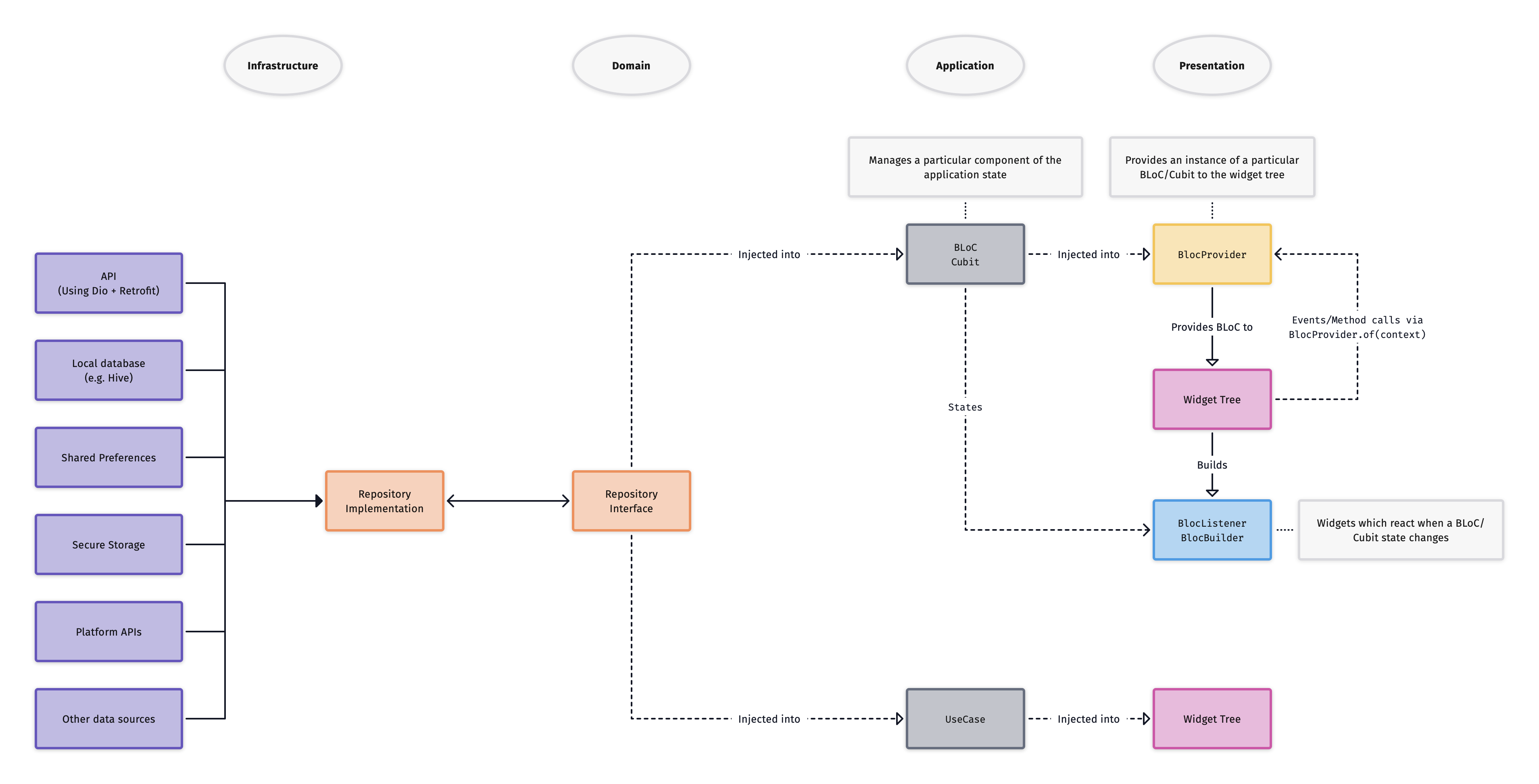Architecture Layers

Flutter projects should contain 4 distinct layers: presentation, application, domain, and infrastructure.
🥞 Layer Definitions
✨ Presentation Layer
The presentation layer should only contain Widgets. Use this layer to implement your user interface.
As much as possible, Widget classes should be free of business logic. Form validation is a reasonable exception to this rule.
Classes in the presentation layer should depend on classes from the application and domain layers.
🤖 Application Layer
This is the main business logic layer of the application, and should contain BLoCs, Cubits, and use-cases.
These classes should depend on entity/value-object classes and repository interfaces from the domain layer.
💭 Domain Layer
Defines the core business domain, including entities, value-objects, and repository interfaces.
These classes should be pure Dart (no Flutter imports) and should not depend on any other layers.
🗄 Infrastructure Layer
This layer contains implementations of the repository interfaces from the domain layer. Repository implementations may depend on other classes like data sources or REST API services.
It's a good idea to use Data Transfer Objects (DTOs) which represent the structure of the data returned from external services. These can then be converted to and from your entity classes. This ensures the entities are not dependent on the data structure of objects returned from external services.
💉 Dependency Injection
get_it + injectable is a fantastic way of implementing dependency injection.
BLoCs and Cubits should be injected into the widget tree using BlocProvider. This allows the BLoC/Cubit to be accessible to all children via BlocProvider.of(context). It also allows BlocListener, BlocBuilder, and BlocConsumer to find instances automatically, and ensures the closure of underlying Streams are handled automatically.
BlocProvider(
create: (_) => GetIt.I<MyBloc>(),
child: BlocBuilder<MyBloc, MyState>(
builder: (context, state) {
// TODO Implement builder
},
),
);
📂 Directory Structure
Most of our projects have the following top-level structure within the lib/ directory:
|- app/
|- core/
|- di/
|- features/
|- l10n/
|- main_production.dart
|- main_staging.dart
app/contains anything to do with the top-levelAppwidget, which may include theming, routing/navigation, and other app-wide functionality.core/can contain anything which can be used throughout the application, like common widgets, models/entities, or services.- The
coredirectory should be split into sub-directories based on the architecture layers e.g.domain,presentationetc.
- The
di/contains dependency injection code, such as environment definitions and modulesfeatures/is where we put our feature-specific code. Each feature should have its own sub-directory, within which we have further sub-directories for architecture layers.l10n/contains internationalization code, as per the Flutter Internationalization guide.- Any entry-points for the application (e.g.
main_staging.dart) should sit at the top-level rather than within any directories.
🏛 Architecture Best Practices
- Stateful Widgets should only be used when absolutely necessary (e.g. when building a form). Most of the time, it's better to use a BLoC with a Stateless Widget.
- As much as possible, classes should depend on interfaces (implemented as abstract classes in Dart), not implementations.
